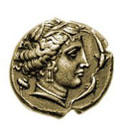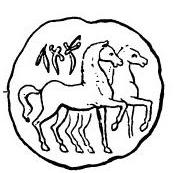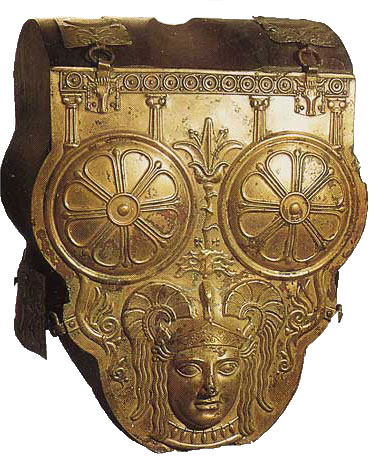
|


Les Problèmes des Isopérimètres et des Isépiphanes
par
Tommy Bonnesen
PARIS
Gauthier-Villars Et Cie
1929


Download the First Ten Pages




 Qasr El-Djem (or El-Jem Amphitheater).
Only the Colosseum of
Rome is larger. It is also known as the Thysdrus Amphitheater,
after the city built by the Romans, at the site of a Punic settlement.
The city and structure faded
into Roman memory after a botched revolt in 238 AD.
The name of the amphitheater and city that houses it preserve the Arab-Aghlabide reference
to what later became Mahdia, only 18 miles away, capital of the Fatimide dynasty founded in the 9th century
by a fervent Kotama Berber king by the name of Obaid al-Allah al-Mahdi.
Mahdia is itself the site of Turris Hannibalis, the last Hannibal Barca saw of Africa before his eastern exile and ultimate suicide in what is today the city of Gebze, 40 miles south-east of Istanbul. Mahdia is also the ancient Africa Aphrodisium, built by Romans at the site of a
comptoir phenicien, settled by Arabs, after the conquest, in the great triangle encompassing
Sousse and Monastir, abandoned for the more grandiose and newly founded
Cairo,
occupied by Roger of Sicily in 1138, then Almohad Berbers in 1160, sieged by the Genoese Louis of Bourbon in 1390, taken by the the Spaniards in 1509, then the Corsair
Dragut, then completely destroyed by
Andrea Doria on behalf of Charles Quint, in 1550, and ultimately partially rebuilt by Ottoman Turks.
In his Book of Wonderful Tales, Al-Bakri (1014-1094) says "El-Jem is the fortress of al-Kahena" (see p. 20), after the Berber queen of the Aures.
In his 1461 geographical dictionary called
The Book of the Fragrant Garden,
Al-Himyari describes the amphitheater as Qasr al-Kahena, or Castle of
the Kahena.
She used it as a refuge in
her battles with Hassan Ibn al-Nu'man al-Ghassani. Food, prepared by her
sister, was secretly brought to her from Salekta
(Roman Syllectum), another 18 miles away. She saw her last stand and ultimate demise, at the age of 105 or 107, at the hands of Hassan ibn al-Nu'man's troops in
Tabarka.
El-Jem was used as refuge earlier by the troops of the Byzantine Gregory, king of Sbeitla and Carthage, both in the 7th century.
The amphitheater survived intact until 1695 when upon the
orders of Mohamed Bey part of it was
blasted to flush out rebels. The
structure was used,
for various purposes, by
New Zealander, American, and German troops during World War II. El-Jem is a contraction of the Arabic al-Ajem which means .. castle, typically a square one (in reference to a
presumed bulkiness)! This amphitheater was featured in a 2008 ad paying
homage to Russell Crowe's epic Gladiator. El-Jem is a Tunisian gem!
Qasr El-Djem (or El-Jem Amphitheater).
Only the Colosseum of
Rome is larger. It is also known as the Thysdrus Amphitheater,
after the city built by the Romans, at the site of a Punic settlement.
The city and structure faded
into Roman memory after a botched revolt in 238 AD.
The name of the amphitheater and city that houses it preserve the Arab-Aghlabide reference
to what later became Mahdia, only 18 miles away, capital of the Fatimide dynasty founded in the 9th century
by a fervent Kotama Berber king by the name of Obaid al-Allah al-Mahdi.
Mahdia is itself the site of Turris Hannibalis, the last Hannibal Barca saw of Africa before his eastern exile and ultimate suicide in what is today the city of Gebze, 40 miles south-east of Istanbul. Mahdia is also the ancient Africa Aphrodisium, built by Romans at the site of a
comptoir phenicien, settled by Arabs, after the conquest, in the great triangle encompassing
Sousse and Monastir, abandoned for the more grandiose and newly founded
Cairo,
occupied by Roger of Sicily in 1138, then Almohad Berbers in 1160, sieged by the Genoese Louis of Bourbon in 1390, taken by the the Spaniards in 1509, then the Corsair
Dragut, then completely destroyed by
Andrea Doria on behalf of Charles Quint, in 1550, and ultimately partially rebuilt by Ottoman Turks.
In his Book of Wonderful Tales, Al-Bakri (1014-1094) says "El-Jem is the fortress of al-Kahena" (see p. 20), after the Berber queen of the Aures.
In his 1461 geographical dictionary called
The Book of the Fragrant Garden,
Al-Himyari describes the amphitheater as Qasr al-Kahena, or Castle of
the Kahena.
She used it as a refuge in
her battles with Hassan Ibn al-Nu'man al-Ghassani. Food, prepared by her
sister, was secretly brought to her from Salekta
(Roman Syllectum), another 18 miles away. She saw her last stand and ultimate demise, at the age of 105 or 107, at the hands of Hassan ibn al-Nu'man's troops in
Tabarka.
El-Jem was used as refuge earlier by the troops of the Byzantine Gregory, king of Sbeitla and Carthage, both in the 7th century.
The amphitheater survived intact until 1695 when upon the
orders of Mohamed Bey part of it was
blasted to flush out rebels. The
structure was used,
for various purposes, by
New Zealander, American, and German troops during World War II. El-Jem is a contraction of the Arabic al-Ajem which means .. castle, typically a square one (in reference to a
presumed bulkiness)! This amphitheater was featured in a 2008 ad paying
homage to Russell Crowe's epic Gladiator. El-Jem is a Tunisian gem!
|
|










